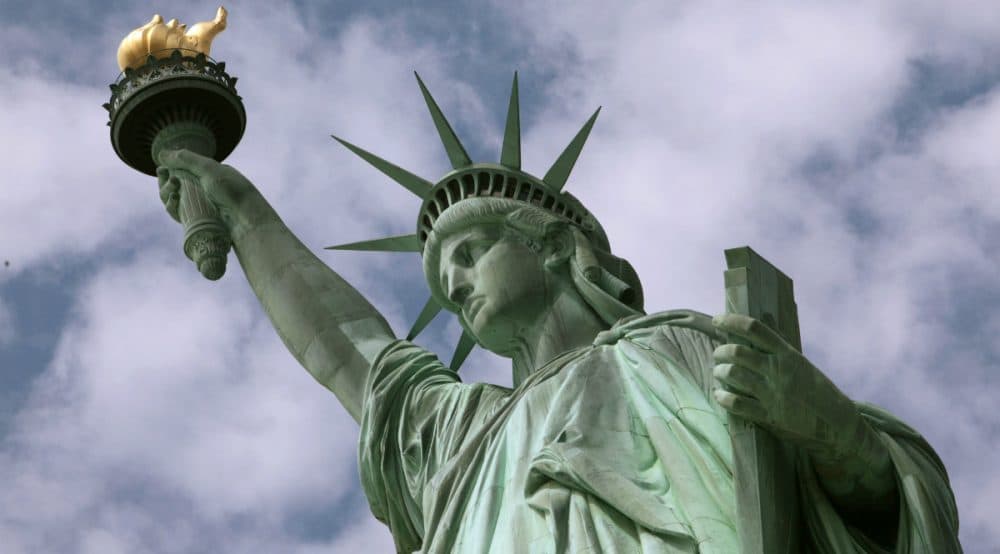Advertisement
When 'The New Colossus' Of New York Wasn't Donald Trump

In January, a hijab and a yellow star got two people ejected amid jeers and taunts from a Donald Trump rally. At another of the GOP presidential frontrunner's rallies last week, a man of color was punched. This should come as no surprise. Nativists have never welcomed Jews and other religious and cultural minorities as legitimate American citizens. All such undesirables only spoil the homeland with bitter flavors that so stubbornly refuse to mix with the more palatable ingredients -- largely Christian and Eurocentric -- in our national ‘melting pot.’ Woeful as it is, xenophobia is a time-honored American tradition. But so is the ideal of a more hospitable message.
Consider the words affixed to a famous gift from a foreign nation:
“Give me your tired, your poor, Your huddled masses yearning to breathe free, The wretched refuse of your teeming shore. Send these, the homeless, tempest-tossed to me, I lift my lamp beside the golden door!”
This sonnet, “The New Colossus,” graces the pedestal of the Statue of Liberty. It was penned in 1883 by Emma Lazarus, one of the first celebrated Jewish-American authors. Bold and brilliant, Lazarus advocated on behalf of immigrants and protested anti-Semitism, economic inequality, the societal limitations imposed on her gender and other injustices.
Lady Liberty’s noble words were silenced with the Immigration Act of 1924, which established the quota system that persisted until the 1960s. No longer were “huddled masses” so welcome.
The Statue of Liberty -- modeled after a Muslim woman in Egypt — was dedicated in 1886. In those years, women were banned from the ballot box. They were also largely barred from the opening ceremony for Lady Liberty, lest their delicate constitution suffer amid the throng of dignitaries. Suffragettes gathered instead in a boat in New York Harbor and pled their cause.
African-Americans felt even less celebratory. An editorial in the black-owned Cincinnati Gazette suggested tossing the statue into the sea until it is “...possible for an inoffensive and industrious colored man to earn a respectable living for himself and family, without being ku-kluxed, perhaps murdered, his daughter and wife outraged, and his property destroyed.”
Originally, the Statue of Liberty symbolized French-American fellowship and political republicanism whereby the people, not a monarch, reign sovereign. Only after affixing Lazarus’s poem to the pedestal in 1903 did Lady Liberty gain her renown as a beacon for immigrants. Lazarus died before her words embellished the plinth. But she wrote the sonnet at the beginning of the classic period of American immigration, when European refugees, including more than 2 million Jews, teamed through Ellis Island and Castle Garden, fleeing pogroms and poverty. Upon the dedication of the tablet, the American Hebrew & Jewish Messenger paid tribute to Lazarus’s “...sympathy with all human suffering and oppression seeking relief in coming to our shores, and her faith in American ideals and institutions.”

Of course, Lady Liberty’s noble words were silenced with the Immigration Act of 1924, which established the quota system that persisted until the 1960s. No longer were “huddled masses” so welcome. On the eve of the Holocaust, in fact, Americans spoke with almost one voice that Jews should be barred, even banished, from the country.
In response to Trump’s recent demagoguery, it was widely reported throughout the Facebook-blogosphere-Twitterverse that a poll in January 1939 -- after Kristallnacht -- revealed that 61 percent of Americans opposed a proposal to admit 10,000 refugee children from Germany, “most of them Jewish.” Why the angst about Jews? Loss of jobs, general fear of foreigners, anxiety over religious differences and widespread dread of a fifth-column of Communists and anarchists — that is, terrorists. Sound familiar?
As a socialist, feminist, pro-refugee, pluralist Jew, Emma Lazarus was exactly the kind of person likely to be booted from a Trump rally.
Lazarus was not an immigrant. She was a fourth-generation American whose family set foot on these shores long before the signing of the Declaration of Independence. Indeed, Lazarus was a women of wealth, aristocratic privilege and rarefied schooling who dwelled worlds away by circumstance from her poor, uneducated, Yiddish-speaking greenhorn brethren. Yet she tirelessly promoted the rights and dignity of all Jews, women and immigrants. As a socialist, feminist, pro-refugee, pluralist Jew, Emma Lazarus was exactly the kind of person likely to be booted from a Trump rally. Surely she, and all those drawn to the now-hallowed words that adorn the Statue of Liberty, should be welcomed to stand as full participants in the American political process and to dine at our multicultural table of prosperity. Otherwise, I agree with the long-deceased black newspaper editor: Toss Lady Liberty into the sea.
